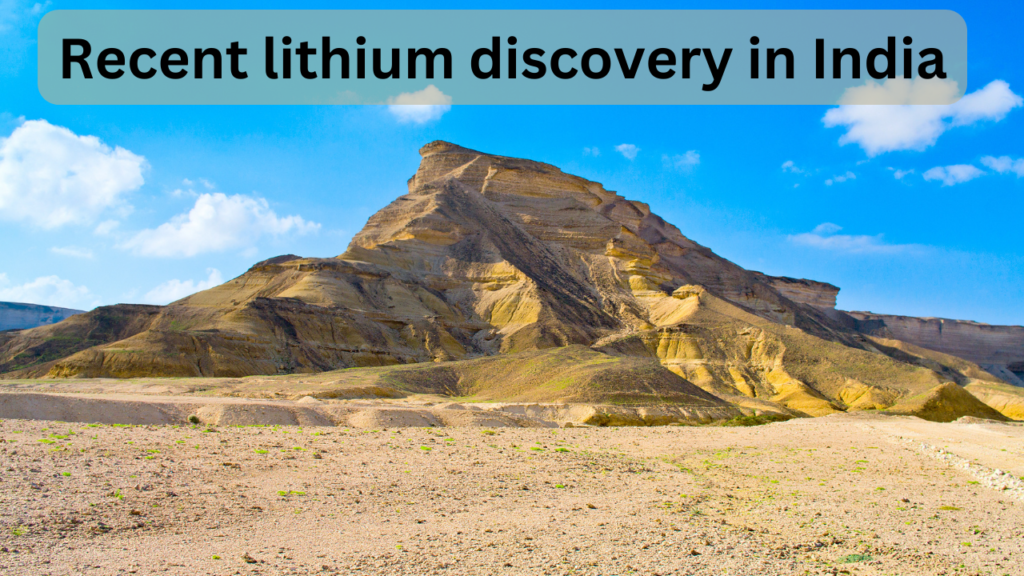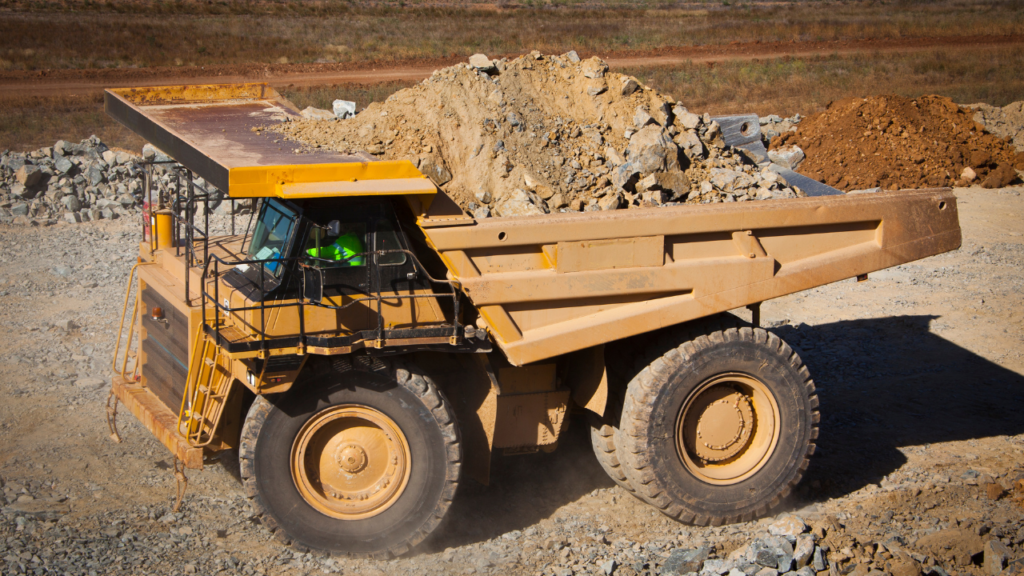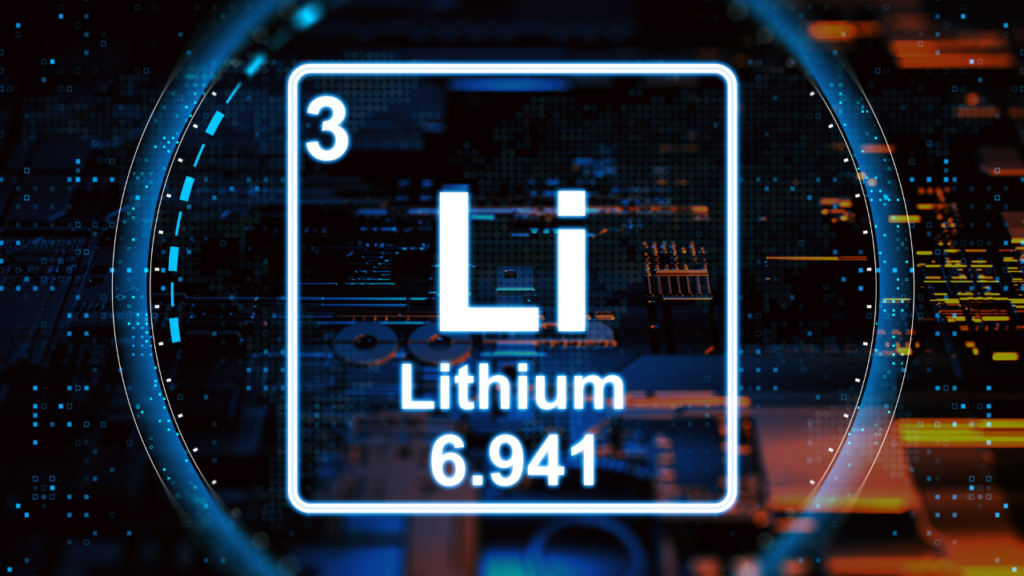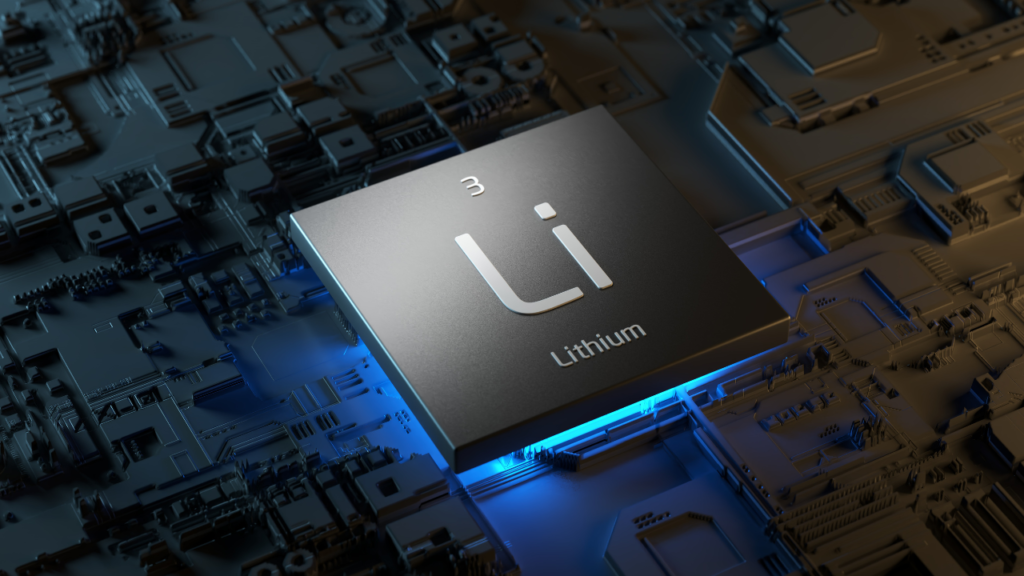Table of Contents
Lithium Mines in India
Lithium mines in India’s reserves are not quite as extensive as those owned by other nations, such as Australia, Chile, and China. India’s lithium reserves are not nearly as huge.
Because the lithium mines in India are still in their infancy, the majority of the focus is now being placed on exploration and the process of determining potential resources.
Lithium, sometimes referred to as “white gold,” plays an essential role as we transition towards renewable energy sources in the modern era.
The demand for lithium has risen as the fundamental component of contemporary rechargeable batteries, which are used in a wide variety of electronic devices, including mobile phones and electric vehicles (EVs).
Recent lithium discovery in India

In recent times, India has made a huge discovery in the Salal-Haimana region of the Reasi District in Jammu and Kashmir.
Estimates place this lithium deposit at 5.9 million metric tons.
This finding places India among the top countries that possess substantial lithium deposits, which has the potential to improve India’s energy independence and promote the country’s electric vehicle (EV) and renewable energy industries.
India is working toward lowering its dependence on imported lithium, which is an essential component in batteries for electric vehicles, mobile phones, and other electronic devices.
The recent lithium discovery in India is believed to be of key importance for India’s transition to clean energy, particularly because the government is working toward this goal.
We anticipate that the discovery will revitalize the local economy, creating employment opportunities and boosting economic growth in the surrounding area.
Mining of lithium in India

The Indian subcontinent’s lithium mining industry is still in its early stages of development. Nonetheless, Khanij Bidesh India Ltd. (KABIL), a sizable joint venture, is composed of three state-owned companies.
The National Aluminium Company Ltd. (NALCO), Mineral Exploration Corp. Ltd., and Hindustan Copper Ltd. are these firms.
We formed this alliance to protect global mining resources, especially those related to cobalt and lithium, which are vital to the production of batteries.
These measures are meant to improve India’s access to these vital minerals, even in the absence of any local lithium mining.
Global lithium mines: An overview

Since lithium is essential for making batteries for electric vehicles (EVs) and energy storage systems, lithium mines all over the world are crucial to the world’s shift to renewable energy and electrification.
Below is a brief description of the worldwide lithium mining industry:
1. Chile: One of the world’s largest lithium producers, Chile mostly gets its supply from salt flats like the Atacama Desert.
Chile evaporates large brine pools to extract lithium, a process believed to offer cheaper production costs than hard-rock mining.
2. **Australia**: With the world’s largest lithium reserves, Australia mines hard rock, mostly lithium-bearing mineral spodumene.
The Greenbushes lithium mine in Western Australia holds one of the world’s largest and highest-grade lithium ore deposits.
3. Argentina: The “Lithium Triangle,” comprising Argentina, Bolivia, and Chile, is believed to contain over half of the world’s lithium reserves. Like Chile, salt brines are the main source of lithium extraction in Argentina.
4. China: Primarily mining lithium from spodumene sources, China is a major participant in both lithium production and processing. In addition to mining, China is the industry leader in battery manufacturing and recycling.
5. Bolivia: Within the Salar de Uyuni, the world’s largest salt flat, lie some of the world’s largest lithium resources.
Unfortunately, a number of political and technical obstacles have restricted its ability to produce lithium.
6. United States: With large lithium resources like those in Nevada’s Clayton Valley, the U.S. has been increasing its output of lithium.
Thacker Pass in Nevada, with its substantial reserves, is poised to emerge as a significant lithium producer.
7. Zimbabwe and Canada: Both countries possess notable spodumene reserves.
Zimbabwe harvests lithium from the Bikita mine, one of the oldest in the world, while Canada concentrates its expanding lithium mining business in areas like Quebec.
8. Portugal: With substantial spodumene reserves and current exploration efforts, Portugal is playing a bigger role in the European lithium scene.
These worldwide lithium reserves are crucial for the energy shift from fossil fuels to renewable sources, both for their immediate economic value and their strategic significance.
How lithium is produced
The two primary processes for producing lithium are rock ore mining and brine deposit extraction. Each procedure operates as follows:
1. Mining from Rock Ore:
Rock ore primarily contains sodumene, the main type of lithium. This ore is extracted from pegmatite formations via mines.
**Concentration:** To concentrate the spodumene at a higher lithium level, the ore is crushed and treated subsequent to mining.
**Calcination:** To transform the concentrated spodumene into a form amenable to chemical treatment, it is fired in a kiln.
**Chemical Processing:** Lithium sulfate is created by treating calcined spodumene with sulfuric acid.
Refining and Precipitation: It is possible to precipitate and purify lithium hydroxide or carbonate for use in batteries and other applications.
2. Recovering from Brine Deposits:
Pumping and Evaporation: Lithium-rich brine is pumped from subterranean reservoirs and spread out across sizable pans to evaporate with the help of solar radiation, a process that may take several months.
**Chemical Extraction:** Following evaporation, chemicals are used to treat the residual salts in order to extract lithium as lithium chloride.
**Conversion to Usable Forms:** Additional chemical reactions subsequently transform lithium chloride into lithium carbonate or lithium hydroxide.
In general, brine extraction is less expensive and less harmful to the environment than mining for rock ore. In nations like Chile and Argentina, which are among the top producers of lithium worldwide, this is the method of choice.
Where lithium is used?
Because of its special chemical and physical characteristics, lithium is a flexible element with a wide range of applications across a variety of sectors. The following are some of the main uses for lithium:
1. Batteries: Lithium is most commonly associated with lithium-ion batteries. These batteries are used in large-scale energy storage systems for renewable energy sources like solar and wind, as well as in electric vehicles (EVs) and portable electronics like laptops and smartphones.
2. Glass and Ceramics: The strength, resilience, and thermal expansion characteristics of glass and ceramics are enhanced by the application of lithium. This increases its value in things like optical lenses and cookware.
3. Lubricants: Lithium greases are widely utilized in industrial and automotive applications because of their great resilience to temperature fluctuations.
4. **Pharmaceuticals**: Mood-stabilizing drugs such as lithium carbonate and lithium citrate are used to treat bipolar disorder by preventing abrupt changes in mood.
5. Air Treatment: Because of their hygroscopic nature, lithium chloride and lithium bromide are utilized in industrial drying systems and air conditioning systems, respectively.
6. Metallurgy: Lithium is alloyed with magnesium and aluminum to produce strong, lightweight metals for use in aviation and other applications.
7. **Nuclear Applications**: Tritium, a radioactive isotope of hydrogen, is produced using lithium and is utilized in nuclear fusion studies.
These various applications highlight lithium’s crucial significance in industrial and medical procedures, as well as in contemporary technology and energy solutions.
Lithium applications in India

In India, lithium is used for a variety of purposes, mostly because of its essential function in energy storage technology. These are the principal uses:
1.Electric vehicles (EVs): Lithium plays a vital role in the lithium-ion batteries that power EVs.
The demand for lithium batteries has surged dramatically as a result of India’s drive towards electric transportation in an effort to cut carbon emissions.
Who is manufacturing lithium ion batteries in India?
The following companies are major manufacturers:
1. Exide Industries: They have established one of the largest lithium-ion battery manufacturing facilities in India in Gujarat in partnership with Leclanche SA of Switzerland.
2. Amara Raja Batteries Ltd.: In pursuance of its strategic expansion, Amara Raja, a renowned manufacturer of automotive batteries, is constructing a specialized lithium-ion battery manufacturing facility.
3.Tata Chemicals is allocating resources towards the development of a lithium-ion battery manufacturing facility in Gujarat, which is its primary investment in this sector.
4. In an attempt to establish manufacturing capabilities on a large scale, Reliance Industries is venturing into the lithium-ion battery production sector via its subsidiary, New Energy Solar Ltd.
5. Furthermore, batteries for Mahindra & Mahindra’s electric vehicle lineup are manufactured by the company’s subsidiary, Mahindra Electric.
6. HBL Power Systems is a supplier of a wide variety of batteries, including lithium-ion batteries, which are intended for use in telecommunications, defense, aerospace, and numerous other industries.
7. “Lithium-Ion Battery Gujarat Private Limited (TDSG)“: This collaborative enterprise was established by TOSHIBA, DENSO, and Suzuki Motor Corporation with a particular emphasis on the manufacturing of lithium-ion batteries for automotive applications.
2.Energy Storage Systems: Large-scale energy storage systems employ lithium batteries as a power source.
By storing extra energy during periods of low demand and releasing it during periods of peak need, these systems assist in controlling the production of renewable energy sources, such as solar and wind power.
3.Devices that are portable: Because of their high energy density and recharging capacity, lithium batteries are frequently used in consumer devices like laptops, tablets, and smartphones.
4.Grid Storage: Lithium-ion batteries are also used in grid applications to control intermittent renewable energy sources and improve system stability.
5.Industrial Applications: Owing to its distinct chemical characteristics, lithium is used in lubricants, glass, and ceramic manufacturing processes, in addition to energy storage and electric vehicles.
Will lithium ion battery explode?
Lithium-ion batteries have the potential to burst or catch fire; however, these occurrences are uncommon and often result from certain situations. The following are the primary causes of these incidents:
1. Thermal Runaway: A battery may explode or catch fire as a result of a chain reaction that quickly raises the temperature and pressure within the battery. It may be caused by utilizing unsuitable chargers, physical damage, overcharging, or manufacturing flaws.
2. **Internal Short Circuit**: Impact or penetration-related battery damage might result in internal short circuits. The separators in the battery that prevent the positive and negative components from coming into contact may become compromised by this damage, which might result in overheating and perhaps an explosion or fire.
3. Inadequate Quality Control: Batteries produced below minimum requirements may contain defects like thin separators, material impurities, or subpar welding, all of which raise the possibility of failure.
4. Overcharging: Protection circuits built into lithium-ion batteries guard against overcharging. But if they malfunction or if a charger doesn’t control the voltage correctly, the voltage may rise beyond what the battery can withstand safely, raising the possibility of an explosion or overheating.
It’s critical to operate the battery, charger, and devices in accordance with the manufacturer’s instructions, keep them out of extreme temperatures, and replace any damaged batteries in order to reduce danger.
The probability of such occurrences may be greatly decreased by handling and storing materials properly.
Is there any lithium mines in India?
As of right now, India has no active lithium-ion mines. In the direction of building such mining operations in the future, the large recent finding of lithium deposits in the Salal-Haimana region of Reasi District in Jammu and Kashmir represents a key milestone.
The only lithium deposit known to exist in India before this discovery was a modest 1600-ton resource located in Mandya, Karnataka.
Although actual mining has not yet started, efforts are still being made to assess and investigate possible lithium mining areas across the states.
In order to get lithium from foreign mines, India’s approach also includes joint ventures and partnerships, such as the one established by Khanij Bidesh India Ltd. (KABIL).
This is because the government recognizes the strategic relevance of lithium for its demands in terms of energy and technology.
Listed lithium mining companies in India
There aren’t any mining firms in India that are solely focused on lithium as of now because the country doesn’t have any operating lithium mines.
The investigation and possible development of lithium deposits, both locally and abroad, is being carried out by a number of Indian businesses and government-owned sectors. A few noteworthy entities are as follows:
The first is Khanij Bidesh India Ltd. (KABIL). This joint venture is being carried out by National Aluminium Company Limited (NALCO), Mineral Exploration Corporation Limited (MECL), and Hindustan Copper Limited (HCL), three state-run subsidiaries. Getting strategic mineral assets like cobalt and lithium overseas is something KABIL does.
2. The company Vedanta Limited.Though mostly concentrated on zinc, lead, silver, oil and gas, iron ore, steel, aluminum, and copper, Vedanta is also investigating potential in the battery metals industry, which includes lithium.
3. Reliance Industries Limited is not a mining firm, but Reliance has demonstrated an interest in the battery manufacturing industry and may work to secure lithium supply as part of a larger plan involving electric cars and renewable energy.
As part of its integrated resource strategy, the Adani Group is exploring renewable energy and may consider mining and/or purchasing lithium, much like Reliance.
These businesses aggressively search for ways to include lithium in their supply chains, especially through partnerships and overseas initiatives, even if they do not already mine the metal.
FAQ
Is lithium available in India?
Yes,India has discovered a significant lithium deposit in the Salal-Haimana region, bringing it to the list of nations with considerable lithium deposits, crucial for electric car batteries, mobile phones, and renewable energy storage systems.
Is there any lithium mines in India?
India currently lacks active lithium-ion mines, but recent lithium deposits in the Salal-Haimana region of Jammu and Kashmir represent a significant milestone. India is assessing potential mining areas and partnering with foreign mines like Khanij Bidesh India Ltd. (KABIL) to obtain lithium from foreign mines, recognizing its strategic importance in energy and technology.
Which company mines lithium in India?
Lithium mining in India is primarily managed by Khanij Bidesh India Ltd, a joint venture comprising NALCO, Hindustan Copper, and Mineral Exploration Corporation, to secure critical mineral resources from overseas locations.
How much lithium does India have?
India has discovered significant lithium reserves, including 5.9 million tonnes in the Salal-Haimana area of Jammu and Kashmir and 80% in Rajasthan’s Degana area. These reserves are crucial for India’s growing demand for battery materials and are expected to meet 80% of its lithium demand. The discovery is in the “inferred resources” category, requiring further assessment before commercial viability. However, the actual mining and production are still in the early stages of planning and development.
Highest lithium producing state in India?
Karnataka is India’s state that produces the most lithium. The Karnataka region of Mandya has emerged as a hub for lithium production in India due to the discovery of significant lithium reserves there. Being the first significant lithium deposit to be found in the nation, this finding is especially noteworthy since it might have a significant impact on India’s electric car and battery manufacturing sectors.
Who imports lithium in India?
India primarily imports lithium from major producers like Australia, Chile, Argentina, and China. Australia is a major producer of lithium, particularly from spodumene ores. Chile is a major supplier of lithium carbonate and hydroxide. Argentina contributes to India’s lithium exports through brine extraction operations. China processes a substantial amount of lithium products, which are then exported to India.
Who is the largest producer of lithium batteries in India?
Exide Industries is the biggest manufacturer of lithium-ion batteries in India as of 2024. At their factory in Gujarat, which they refer to as the country’s largest lithium-ion battery facility, they have started mass production.
Who owns lithium mines India?
The Ministry of Mines in India is collaborating with key companies like National Aluminium Company Ltd, Mineral Exploration Corporation Ltd, and Hindustan Copper Ltd to explore and potentially mine lithium and other strategic minerals both within India and abroad through the joint venture company Khanji Bidesh India Ltd.
Which country has the most lithium mines?
Australia is the world’s largest lithium producer, with the most lithium mines. The country primarily mines from hard-rock sources, particularly spodumene, for use in electric vehicle batteries and other high-tech applications. Major lithium mines are located in Western Australia, with the Greenbushes mine being one of the largest and highest-grade operations globally.
Is there lithium mines in the us?
Yes, there are lithium mines in the United States. Lithium mines in the U.S. include Silver Peak in Nevada, operated by Albemarle Corporation, which extracts lithium from brine pools using evaporation. Thacker Pass, near the Oregon border, is a significant lithium deposit, and Clayton Valley, adjacent to Silver Peak, is being explored for new projects.
Where lithium is used?
Lithium, a flexible element with diverse applications, is used in batteries, glass and ceramics, lubricants, pharmaceuticals, air treatment, metals, and nuclear research. Its chemical and physical properties enhance its value in various industries, including batteries, glass and ceramics, pharmaceuticals, air treatment, and nuclear fusion studies.
Where are the major lithium mines?
Major lithium mines are located in Australia, Chile, Argentina, China, the United States, Zimbabwe, and Portugal. Australia is the largest producer, Chile extracts from brine resources, Argentina extracts from salt flats, China focuses on hard-rock mining, and the United States has potential sources.